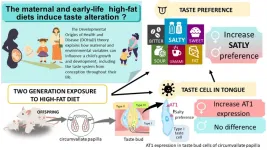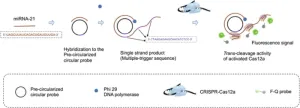(Press-News.org) Researchers at Karolinska Institutet in Sweden have investigated how preterm birth and foetal growth are related to the risk of atrial fibrillation up to middle-age. The study, which is published in JAMA Pediatrics, shows that being born preterm or large for gestational age was associated with increased risks of atrial fibrillation later in life. Being small for gestational age at birth was only associated with an increased risk of atrial fibrillation up to the age of 18.
The incidence of atrial fibrillation in the young has increased over the past few decades, from low levels.
“Atrial fibrillation at a young age may involve a heavy socioeconomic burden for the affected individuals and we need to learn more about the underlying causes of the disease,” says the paper’s first author Fen Yang, doctoral student at the Department of Global Health, Karolinska Institutet. “Our findings may highlight the need to monitor and prevent the disease in individuals with an elevated risk of atrial fibrillation.”
According to the National Board of Health and Welfare, approximately five percent of babies born in Sweden are preterm (i.e. born before week 37). Previous studies have shown that those born preterm or with foetal growth restriction are slightly more likely to develop cardiovascular diseases, such as ischemic heart disease, stroke and heart failure, later on in life.
Low incidence in the young
To date there have been little or mixed findings regarding the risk of atrial fibrillation in those with adverse birth outcomes. Atrial fibrillation increases the risk of stroke and other cardiovascular conditions, and is the most common form of cardiac arrhythmia. It mainly affects the middle-aged and the elderly. The estimated incidence in the young is low, 0.12 to 0.16 percent.
A collaborative study involving researchers from Karolinska Institutet has now investigated the risk of atrial fibrillation according to preterm birth and foetal growth.
“We found that individuals born preterm and those who were large for gestational age at birth had a slightly higher risk of developing atrial fibrillation up to middle-age than those with corresponding normal birth outcomes,” says principal investigator Krisztina László, associate professor at the Department of Global Public Health, Karolinska Institutet, and senior lecturer at the Department of Public Health and Caring Sciences at Uppsala University. “Individuals who were small for gestational age at birth had an increased risk of atrial fibrillation up to the age of 18, but not later in adulthood.”
The risk increase was 30 per cent for individuals born preterm, 55 per cent for individuals who were large at birth and 71 per cent for individuals who were both preterm and large for gestational age at birth.
Eight million participants
The results of the study are based on statistical analyses of over eight million births from Danish (1978–2016), Finnish (1987–2014) and Swedish (1973–2014) medical birth registries who were followed for incident atrial fibrillation in the national patient and cause of death registries up to 2021. The results were compared with siblings in the same families. Since the study was observational, no causal relationships could be ascertained.
The researchers say that future studies may investigate the association between preterm birth, foetal growth, and the risk of atrial fibrillation up to old age.
The study was a collaboration among researchers at Karolinska Institutet, Uppsala University, Aarhus University (Denmark), the Norwegian University of Science and Technology, the Finnish Institute of Health and Welfare and Fudan University (China).
It was financed primarily by the Swedish Research Council for Health, Working Life and Welfare (FORTE), Karolinska Institutet’s Research Foundation, the Swedish Heart Lung Foundation and the Chinese Scholarship Council (see the paper for further details). The researchers report no conflicts of interest.
Publication: “Preterm birth, small and large for gestational age and the risk of atrial fibrillation up to middle-age: a Nordic cohort study”. Fen Yang, Imre Janszky, Mika Gissler, Sven Cnattingius, Nathalie Roos, Maohua Miao, Wei Yuan, Jiong Li, Krisztina D. László. JAMA Pediatrics, online 24 April 2023, doi: 10.1001/jamapediatrics.2023.0083.
END
New insights on the risk for atrial fibrillation in children and young adults
2023-04-24
ELSE PRESS RELEASES FROM THIS DATE:
Vaccine printer could help vaccines reach more people
2023-04-24
CAMBRIDGE, MA -- Getting vaccines to people who need them isn’t always easy. Many vaccines require cold storage, making it difficult to ship them to remote areas that don’t have the necessary infrastructure.
MIT researchers have come up with a possible solution to this problem: a mobile vaccine printer that could be scaled up to produce hundreds of vaccine doses in a day. This kind of printer, which can fit on a tabletop, could be deployed anywhere vaccines are needed, the researchers say.
“We could someday ...
Scientists have full state of a quantum liquid down cold
2023-04-24
A team of physicists has illuminated certain properties of quantum systems by observing how their fluctuations spread over time. The research offers an intricate understanding of a complex phenomenon that is foundational to quantum computing—a method that can perform certain calculations significantly more efficiently than conventional computing.
“In an era of quantum computing it’s vital to generate a precise characterization of the systems we are building,” explains Dries Sels, an assistant ...
Massive iceberg discharges during the last ice age had no impact on nearby Greenland, raising new questions about climate dynamics
2023-04-24
CORVALLIS, Ore. – During the last ice age, massive icebergs periodically broke off from an ice sheet covering a large swath of North America and discharged rapidly melting ice into the North Atlantic Ocean around Greenland, triggering abrupt climate change impacts across the globe.
These sudden episodes, called Heinrich Events, occurred between 16,000 and 60,000 years ago. They altered the circulation of the world’s oceans, spurring cooling in the North Atlantic and impacting monsoon rainfall around the world.
But ...
New biologic effective against major infection in early tests
2023-04-24
Researchers at NYU Grossman School of Medicine and Janssen Biotech, Inc. have shown in early tests that a bioengineered drug candidate can counter infection with Staphylococcus aureus – a bacterial species widely resistant to antibiotics and a major cause of death in hospitalized patients.
Experiments demonstrated that SM1B74, an antibacterial biologic agent, was superior to a standard antibiotic drug at treating mice infected with S. aureus, including its treatment-resistant form known as MRSA.
Published ...
Researchers develop new tools for precise large DNA insertions
2023-04-24
GAO Caixia's group from the Institute of Genetics and Developmental Biology of the Chinese Academy of Sciences (CAS) has developed a new genome editing technology that achieves efficient and precise targeted insertion of large DNA segments in plants.
The new technology, called prime editing-mediated recombination of opportune targets (PrimeRoot), combines an optimized dual-ePPE editor protein previously published by the group with a highly efficient tyrosine site-specific recombinase, Cre. It can achieve ...
Researchers ID novel treatment pathway for deadly pancreatic cancers
2023-04-24
Researchers at the Johns Hopkins Kimmel Cancer Center identified a novel cell signaling pathway that potentially could be targeted in therapy for patients with aggressive pancreatic cancers.
In laboratory studies with human pancreatic cancer cell lines and genetically engineered mouse models of pancreatic cancer, the investigators discovered that the High Mobility Group A1 (HMGA1) protein functions as a “molecular switch” that “flips on” genes required by tumor cells to grow in an uncontrolled fashion and form invasive tumors. One of these genes activated ...
Maternal and early-life high-fat diets result in a taste for salty food
2023-04-24
Tokyo, Japan – We are all aware of the importance of eating healthy food, especially during pregnancy. A high-fat diet has dramatic consequences on the metabolism. It can lead to obesity, diabetes, chronic liver disease, and possibly cancer. Previous works have demonstrated that eating high amounts of fat during pregnancy affects the taste preference and metabolism in offspring. In most households, children and parents eat the same food. In other words, mums eating a high-fat diet will likely feed their children fatty foods. What are the consequences of maternal ...
NFL PLAY 60 Fitness Break broadcast keeps kids active in advance of the NFL Draft
2023-04-24
DALLAS, April 24, 2023 — The American Heart Association and the National Football League (NFL), in collaboration with its 32 NFL clubs, are challenging kids to move more with an NFL PLAY 60 Fitness Break for the NFL Draft happening later this week. The free program on Wednesday, April 26 at 1 p.m. ET/ 12 p.m. CT/ 10 a.m. PT will offer a 15-minute synchronous broadcast to help students learn how to add movement to their day leading up to the live Draft coverage from Kansas City.
Rooted in American Heart Association science, the Fitness Break broadcast helps students learn more about how physical activity supports ...
A panoramic view on lithium-mediated electrochemical dinitrogen reduction reaction
2023-04-24
The Haber-Bosch process is the industrial approach for NH3 production today, which must be operated at energy-intensive high temperatures and pressures. The reduction of dinitrogen (N2) by electrocatalysis offers an alternative way for NH3 production at ambient conditions and a variety of electrocatalysts have been studied over the past few years. However, even the best catalytic system reported could only get unsatisfied performance (such as the selectivity and production rate of NH3) due to the ...
Unveiling a fast and efficient method for detecting microRNAs
2023-04-24
In the early 1990s, scientists who were studying the development of a roundworm identified a small RNA molecule that regulated the expression of specific genes. This marked the discovery of microRNAs (miRNAs), which are now known to be present across all forms of life. As it turns out, these molecules play essential roles in many biological processes.
A few years later, researchers realized that diseases could dysregulate the expression of miRNAs, highlighting their potential as biomarkers. In fact, abnormal miRNA expression is a hallmark of all tumor-related diseases. Thus, miRNA detection techniques ...







